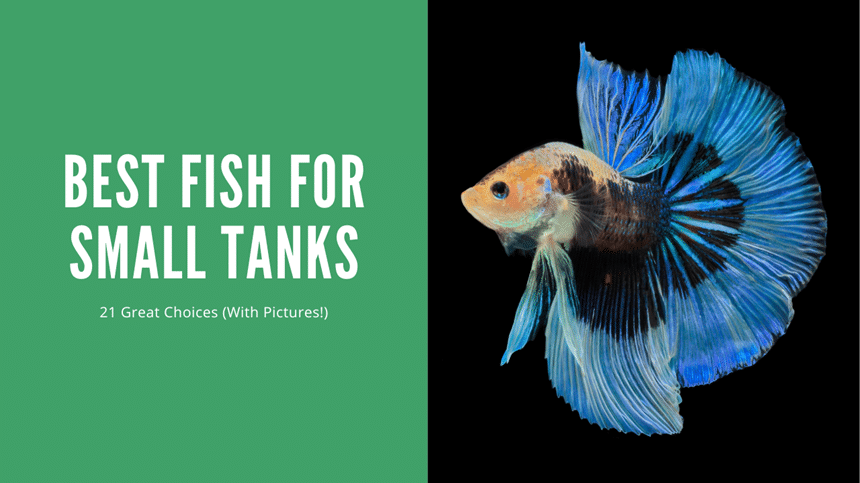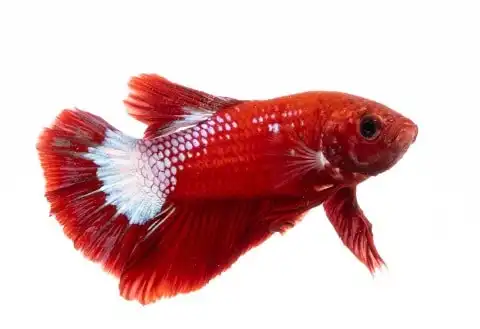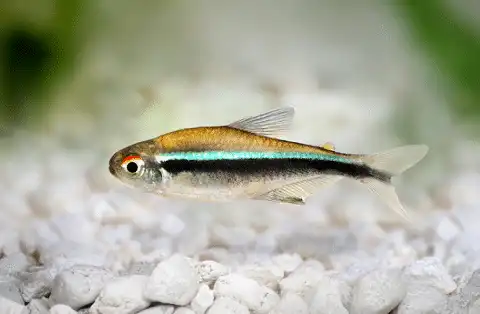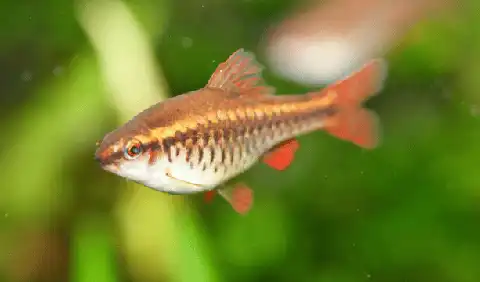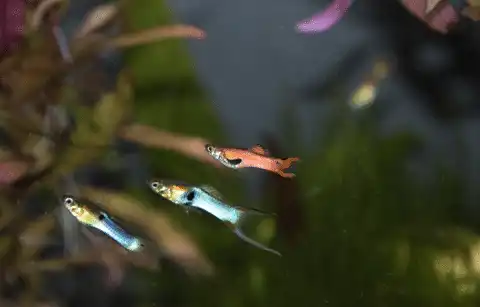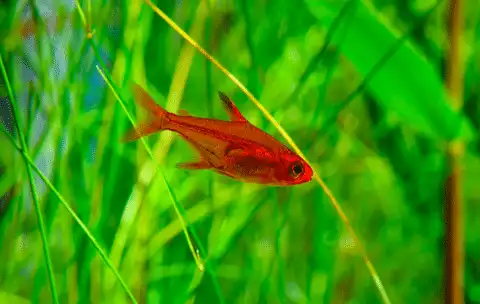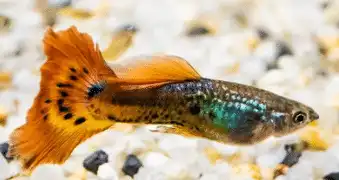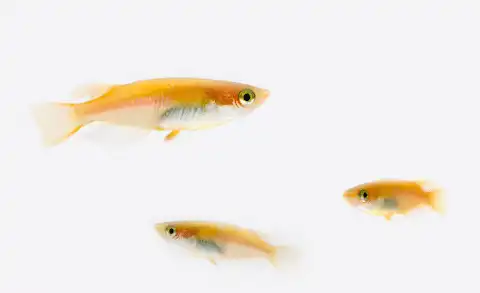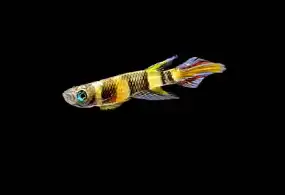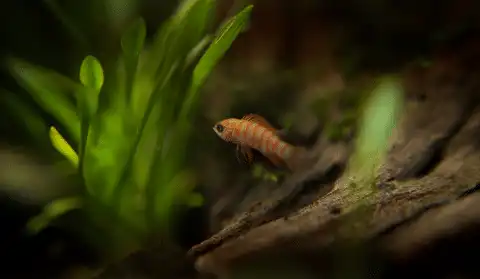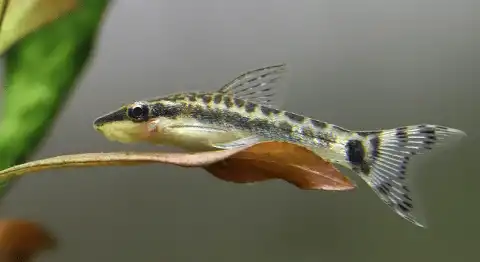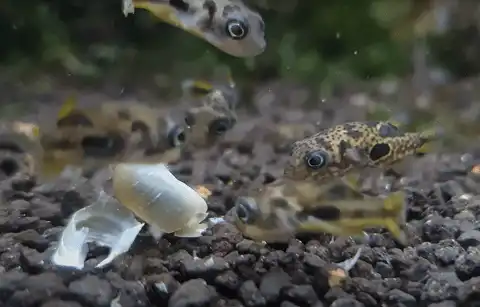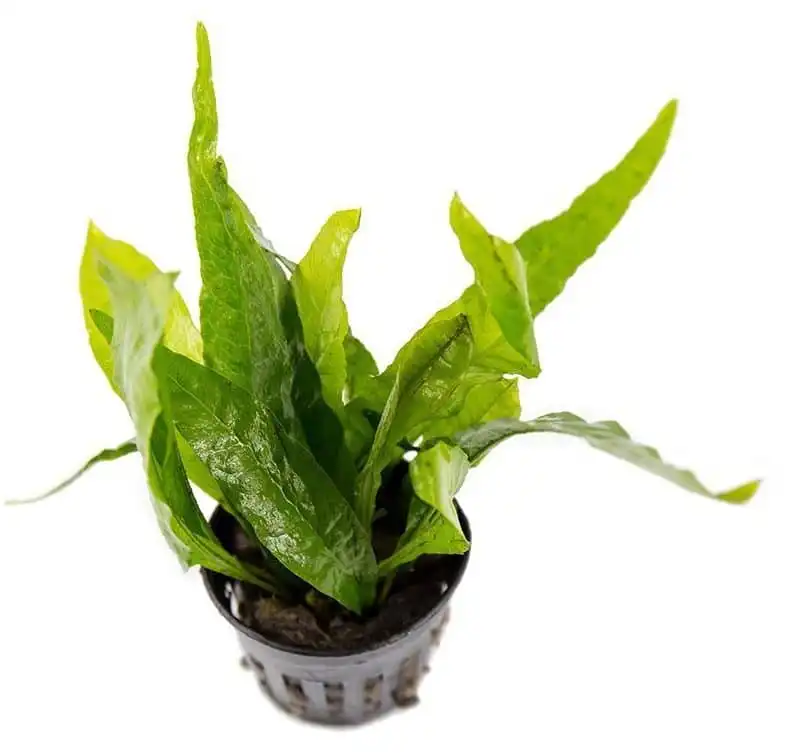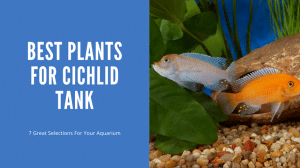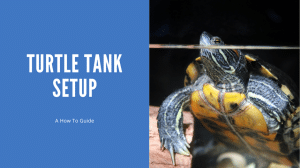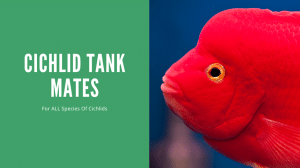Thank you for visiting! By the way… any links on this page that lead to products on Amazon and other stores/partners are affiliate links Aquarium Store Depot earns a commission if you make a purchase.
Are you planning a new fish tank or just looking for a new small fish species to add to an existing community? Choosing new fish is super fun, but it can be tough to make the right choice.
There are hundreds of different species in the fishkeeping hobby, so save yourself the stress and scroll through this list to help make your choice. All the fish mentioned in this guide can be kept in tanks of 15-20 gallons, and some can even live in aquariums as small as 5 gallons.
Ready? Let’s meet the 21 best small fish for freshwater aquariums!
Key Takeaways
- Small freshwater fish make fascinating pets, and a well-planned display tank can make a big impact in any space.
- Schooling fish are easily stressed if kept alone. They should be kept in groups of at least 5 or 6 of their own species.
- Small freshwater fish need good filtration and regular water changes to stay healthy. Tropical species should be kept in a temperature-controlled, heated tank.
- Choose peaceful species with similar temperature and water parameter preferences when starting a community tank. Each fish should be comfortable in its new home.
The 21 Best Fish For Small Tanks
It’s time to learn about 21 excellent freshwater fish for small tanks! Take note of their minimum tank size, diet requirements, and other important stats before choosing your next pet. We have a video below from our YouTube Channel, so you can watch along while seeing more details below from our blog!
1. Bettas
Use Coupon Code ASDFISH at Checkout
Betta Fish are one of the most beautiful varieties of freshwater fish available in the hobby. Easy to care for with plenty of varieties!
- Scientific Name: Betta splendens
- Adult Size: 2.5 inches
- Care Level: Beginner
- Temperament: Aggressive
- Minimum Tank Size: 5 gallons
- Diet: Carnivore, feed good quality micro-pellets and live/frozen bloodworms and brine shrimp
- Origin: Thailand and other countries in Southeast Asia
- Temperature: 76-80 °F
- Swimming Level: Mid/upper layers
The betta or Siamese fighting fish is a great choice for any freshwater aquarium that holds 5 gallons or more. These popular freshwater fish can live more than three years with good care and their bright colors and fancy fins make them great centerpiece fish.
Bettas get along great with many different tank mates in community setups, just don’t make the mistake of keeping more than one male in the same tank. These guys love to fight!
2. Exclamation Point Rasbora
One of the smallest fish available in the hobby. Best in schools and easy to care for
- Scientific Name: Boraras urophthalmoides
- Adult Size: 0.5 inches
- Care Level: Intermediate
- Temperament: Peaceful and shy
- Minimum Tank Size: 10 gallons
- Diet: Carnivore, feed crushed flake fish food, baby brine shrimp and blood worms
- Origin: Thailand
- Temperature: 68 – 82°F
- Swimming Level: Middle layers
The exclamation point rasbora is an awesome little freshwater nano fish with an orange body and a black exclamation (!) symbol on each side.
These tiny fish are pretty shy (probably because they’re so small) so they need the company of at least 10 of their own kind to form a nice school. Keep these peaceful fish in a densely planted tank to enjoy all they have to offer.
3. Chili Rasbora
Use Promo Code ASDFLIPPROMO
A great nano schooling fish. Males display brighter colors. Best in groups of 6 or more
- Scientific Name: Boraras brigittae
- Adult Size: 0.75 inches
- Care Level: Intermediate
- Temperament: Peaceful
- Minimum Tank Size: 10 gallons
- Diet: Carnivore, feed granules and live/frozen foods
- Origin: Southeast Asia
- Temperature: 68 – 82°F
- Swimming Level: Middle and upper layers
Also known as the mosquito rasbora, these peaceful schooling fish are similar to the exclamation point rasbora but have a redder body color. These are true micro fish that are perfect for small tanks.
While it is possible to keep a small school in a 5-gallon tank, they’ll do much better in a 10 gallon tank with plenty of live aquarium plants.
4. Zebra Danio
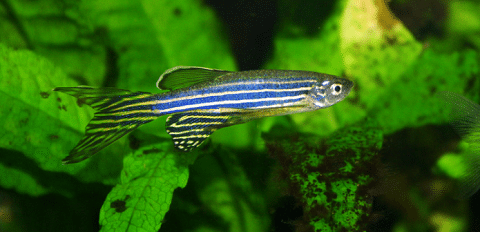
- Scientific Name: Danio/Brachydanio rerio
- Adult Size: 2 inches
- Care Level: Beginner
- Temperament: Very peaceful
- Minimum Tank Size: 10 gallons
- Diet: Carnivore, feed good quality dried foods and bloodworms or other insect larvae
- Origin: South Asia
- Temperature: 66 – 77°F
- Swimming Level: Generally middle and upper layers
The zebra danio is a great beginner fish species for a small freshwater aquarium. There are many other beautiful danio species (celestial pearl, glowlight, etc.) in the hobby, but the good ol’ zebra fish tends to be the cheapest and most adaptable species.
These small fish are very peaceful and hardy, making them a great small aquarium fish species for a community tank. The minimum tank size for these fish is about 10 gallons, but they’ll be much happier in a 20-gallon tank where there’s plenty of space to swim.
5. Black Neon Tetra
A variant neon variety. More reliant than neon and cardinal tetras
- Scientific Name: Hyphessobrycon herbertaxelrodi
- Adult Size: 1.5 inches
- Care Level: Beginner
- Temperament: Peaceful
- Minimum Tank Size: 15 gallons
- Diet: Omnivore, feed a quality pellet/flake and live/frozen food
- Origin: South America
- Temperature: 70 – 82°F
- Swimming Level: Middle and upper layers
The black neon tetra doesn’t get quite as much love as the regular neons and cardinal tetras, but black neons are actually the better choice for many aquarists because they are so easy to care for. A school of 5 or 6 of these beautiful fish will add constant motion to the open-water areas of a small tropical fish tank.
These guys are pretty hardy, and much more likely to survive some of the common beginner fishkeeping mistakes. They look great too, and they get along perfectly with other peaceful fish.
6. Cory Catfish

- Scientific Name: Corydoras spp.
- Adult Size: 1-3 inches
- Care Level: Beginner/intermediate
- Temperament: Very peaceful
- Minimum Tank Size: Species-dependent
- Diet: Omnivorous, feed sinking tablets/pellets and frozen foods
- Origin: South America
- Temperature: Species-dependent, most types can be kept in the mid-70s Fahrenheit
- Swimming Level: Bottom dweller
Looking for an interesting bottom dweller for a small community tank? Look no further than the cories, a large group of schooling catfish from South America. These fascinating freshwater fish spend most of their time searching the substrate for food scraps, but every now and then they rocket up to the surface for a gulp of air.
The smallest species (dwarf, pygmy corydoras, etc.) grow to less than an inch and can be kept in a ten-gallon tank, but most species will need an aquarium size of 20 gallons or more.
7. White Cloud Mountain Minnow
A very peaceful fish that does well in coldwater fish. Other minnow varieties are also available
- Scientific Name: Tanichthys albonubes
- Adult Size: 1.5 inches
- Care Level: Easy
- Temperament: Peaceful
- Minimum Tank Size: 10 gallons
- Diet: Carnivore, feed high-quality dried foods supplemented with frozen blood worms/ brine shrimp
- Origin: China
- Temperature: 60-72°F
- Swimming Level: Middle and upper layers
The white cloud mountain minnow is a coldwater fish, even though it offers all the bright colors of a tropical fish species.
These peaceful fish will thrive in an unheated aquarium in most homes, although they can be kept with some tropical fish that enjoy water in the low 70’s. The white cloud mountain minnow is a social fish, so you’ll need a school of at least six to keep them confident.
8. Cherry Barb
- Scientific Name: Puntius titteya
- Adult Size: 1.5 – 2 inches
- Care Level: Beginner
- Temperament: Peaceful
- Minimum Tank Size: 15 gallons
- Diet: Omnivore, feed quality fish flakes or micro pellets and live/frozen food
- Origin: Sri Lanka
- Temperature: 70 – 79°F
- Swimming Level: Middle to lower levels
The cherry barb is a beautiful freshwater schooling fish from South Asia with attractive scales and rounded fins. Males develop a beautiful cherry-red color, but the females also have a rich amber/orange shade.
Cherry barbs are great community fish that add life to the lower levels of the aquarium. They get along great with other peaceful fish but will do best in a larger tank (20 gallons+) if they need to share their space with other species. A school of 6 or more is recommended to see them at their best.
9. Endler’s Livebearers
A very active and colorful livebearer. Smaller in size than guppies
- Scientific Name: Poecilia wingei
- Adult Size: 1 – 2 inches, males reach just one inch
- Care Level: Beginner
- Temperament: Peaceful
- Minimum Tank Size: 10 gallons
- Diet: Omnivore, provide a quality flake or micro-pellet and occasional frozen/live foods
- Origin: Venezuela
- Temperature: 64 – 82°F
- Swimming Level: All levels but mostly in the upper half
The Endler’s livebearer is a colorful little fish that looks similar to a regular fancy guppy. However, this closely related fish is a smaller species and purebred specimens are much rarer. Ideally, Endlers should not be kept in the same tank as guppies because the two will readily hybridize.
Endlers are confident, active little fish that are very easy to care for. These fish breed easily, so you can expect to see some babies (fry) if you keep males and females together. They’re very peaceful too, so you can keep them with other nano community fish.
10. Honey Gourami
One of the more peaceful Gourami fish available in the hobby. Has a unique yellow coloration and only grows up to 2 inches in length
- Scientific Name: Trichogaster chuna
- Adult Size: up to 2 inches
- Care Level: Beginner
- Temperament: Peaceful
- Minimum Tank Size: 10 gallons for a single fish, 20 gallons for a pair
- Diet: Carnivore, feed a quality micro-pellet or flake, and occasional live/frozen foods
- Origin: India and Bangladesh
- Temperature: 74-80°F
- Swimming Level: Middle and upper layers
The honey gourami is a small, peaceful fish species that can be kept as a single centerpiece fish or as a pair in a small community fish tank.
The males develop their brightest colors before the breeding season, but these peaceful nano fish are attractive and interesting at any time of the year.
11. Ember Tetra
A small red tetra that grows up to 1.25 inches. A very peaceful schooling fish
- Scientific Name: Hyphessobrycon amandae
- Adult Size: 0.75 inches
- Care Level: Beginner
- Temperament: Peaceful
- Minimum Tank Size: 10 gallons
- Diet: Carnivore, feed micro-pellets/ flakes and live/frozen foods
- Origin: Brazil
- Temperature: 72-80°F
- Swimming Level: Middle levels
The ember tetra is a nano schooling fish with a deep orange color. These tiny tetras grow to three-quarters of an inch or so, making them a good choice for tanks as small as 5 gallons. However, they will be much better off in a tank of over 10 gallons, especially in a school of 10 or more.
Ember tetras are an option for a small community tank, although they should not be kept with large or aggressive fish due to their small size.
12. Guppies
An undemanding fish that is a livebearer. Many varieties available
- Scientific Name: Poecilia reticulata
- Adult Size: 0.75 – 2.5 inches
- Care Level: Easy
- Temperament: Peaceful
- Minimum Tank Size: 10 gallons
- Diet: Omnivorous, feed high-quality dried and live/frozen foods
- Origin: Northern South America and the Caribbean
- Temperature: 72-82°F
- Swimming Level: All levels
Fancy guppies are excellent nano fish for smaller fish tanks, especially if you have naturally hard water. These colorful livebearers are very easy to keep and super easy to breed in a home aquarium.
Guppies come in a variety of colors, and some high-quality strains are very rare and valuable. However, you can usually find some beautiful fancy guppies at your local fish store for a very reasonable price. You can keep only males or groups with three females to one male.
13. Japanese Rice Fish
Japanese rice fish are a commonly overlooked fish suitable for freshwater aquascapes. Very peaceful and hardy fish that color up with companions
- Scientific Name: Oryzias latipes
- Adult Size: 1.2 inches
- Care Level: Easy
- Temperament: Peaceful
- Minimum Tank Size: 10 gallons
- Diet: Omnivore, feed a quality flake food and supplemental live/frozen foods
- Origin: Eastern Asia
- Temperature: 61 – 75°F
- Swimming Level: Middle and upper levels
The Medaka, or Japanese rice fish is becoming increasingly popular in the aquarium trade. They are available in a variety of colors, ranging from white to orange.
These nano fish prefer cool water, making them a great choice for an unheated tank. They can be kept with other peaceful fish like white cloud minnows, just avoid tropical species that need warm water temperatures.
14. Rainbow Shiner
- Scientific Name: Notropis chrosomus
- Adult Size: 2-3 inches
- Care Level: Beginner
- Temperament: Peaceful
- Minimum Tank Size: 15 gallons
- Diet: Omnivore, provide a good quality dried food and frozen/live foods as treats
- Origin: Southeastern USA
- Temperature: 50 – 72°F
- Swimming Level: Middle and upper layers
The rainbow shiner is an awesome native fish species that hails from the United States. They are a pretty new fish species in the fish keeping hobby and difficult to find at most fish stores, but you can often pick them up online. Choose this species as the centerpiece for a cool water stream biotope tank.
In spawning colors, these guys are some of the best-looking fish out there, although not all specimens develop amazing colors, and females are not particularly colorful. Keep a school of at least 6 of these fish in a small cool water tank with good water flow.
15. Spotted Blue-Eye Rainbowfish

- Scientific Name: Pseudomugil gertrudae
- Adult Size: 1-1.5 inches
- Care Level: Beginner/intermediate
- Temperament: Peaceful but shy
- Minimum Tank Size: 10 gallons
- Diet: Omnivore, feed crushed dried foods and small live/frozen foods
- Origin: Indonesia and Northern Australia
- Temperature: 72-82°F
- Swimming Level: Generally in the top and middle levels
The spotted blue-eye rainbowfish is an interesting nano species that thrives in small planted aquariums. Both sexes are very attractive, although only the males develop large and interesting anal and dorsal fins.
Spotted blue-eye rainbowfish can be pretty shy around other fish, so they’re best kept in their own planted tank. It is possible to keep this species with adult shrimp, but there’s always some risk when keeping fish and inverts together. Keep a shoal of 8 or more of these fish to see their confident natural behaviors.
16. Green Fire Tetra
- Scientific Name: Aphyocharax rathbuni
- Adult Size: 1.5-1.75 inches
- Care Level: Beginner
- Temperament: Semi-aggressive
- Minimum Tank Size: 15 gallons
- Diet: Feed good quality dried foods and live/frozen foods
- Origin: Brazil, Uraguay, Argentina, Paraguay
- Temperature: 70 – 79°F
- Swimming Level: Midwater levels
The green fire tetra is an active little South American tetra that will add color and movement to any nano tank. You might find them for sale as Rathbun’s tetra or the redflank bloodfin, but they are all the same awesome nano species.
Unfortunately, green fire tetras have a reputation for fin nipping, so it’s safest to keep them with fast-moving fish that can hold their own, and avoid any species with long, flowing fins.
17. Clown Killifish
- Scientific Name: Epiplatys annulatus
- Adult Size: 1.25 inches
- Care Level: Beginner/intermediate
- Temperament: Peaceful
- Minimum Tank Size: 10 gallons
- Diet: Carnivore, feed dried food for nano fish and live/frozen foods
- Origin: West Africa
- Temperature: 68 – 78°F
- Swimming Level: Upper levels
Also known as the banded panchax, these tiny surface dwellers are a great choice for a nano tank full of healthy green plants that mimic their natural forest habitat.
The clown killifish can be kept with other nano fish but will be most comfortable if you keep a school of at least 8 specimens.
18. Scarlet Badis
A great colorful nano fish. They are known for being semi-aggressive. Best if keep solo or in pairs
- Scientific Name: Dario dario
- Adult Size: 0.5 – 0.75 inches
- Care Level: Intermediate
- Temperament: Peaceful
- Minimum Tank Size: 10 gallons
- Diet: Omnivore
- Origin: India
- Temperature: 70- 79°F
- Swimming Level: Bottom
The scarlet badis is a tiny fish species from India that looks similar to a dwarf cichlid. These colorful little fish can be kept in tanks as small as 5 gallons, although maintaining great water quality is much easier in a larger setup.
The scarlet badis is a great choice for fish keepers with a few years of experience. They can be a little fussy around meal times, so you’ll probably need a supply of live or frozen foods to keep them well-fed.
These fish should not be kept with larger, more aggressive species, although they will thrive in a planted tank with other smaller fish like celestial pearl danios (AKA Galaxy Rasbora).
19. Licorice Gourami

- Scientific Name: Parosphromenus deissneri
- Adult Size: 1.5 inches
- Care Level: Intermediate
- Temperament: Can be somewhat aggressive
- Minimum Tank Size: 5 gallons
- Diet: Carnivore, feed live foods like bloodworm and tubifex worm
- Origin: Indonesia
- Temperature: 72 – 82°F
- Swimming Level: Middle layers
The licorice gourami is a fascinating nano fish species for more experienced fish keepers. These fish do well in tanks as small as 5 gallons, but they require soft, acidic water and gentle filtration to simulate their natural habitat.
Licorice gouramis are often kept as a single centerpiece fish due to their slightly aggressive nature, although you can keep them with other small, peaceful fish in a tank with plenty of cover and live plants.
20. Otocinclus Catfish
A small algae-eating fish. Also great with freshwater shrimp.
- Scientific Name: Otocinclus spp.
- Adult Size: 1.5 inches
- Care Level: Moderate
- Temperament: Very peaceful
- Minimum Tank Size: 20 gallons
- Diet: Algae eater. Can be fed soft greens and algae wafers but requires a source of natural algae
- Origin: South America
- Temperature: 70 – 77°F
- Swimming Level: Feeds on hardscape, glass, and plants at all levels
The otocinclus catfish is one of my favorite nano fish and one of the most useful clean-up crew species in the hobby. However, these little guys have some special requirements, and they rarely survive in a new tank without a steady supply of algae.
Despite their small size, these algae eaters do best in mature tanks of 20 gallons or more that can provide enough natural food to sustain a school of 6 or more. Otos are very peaceful fish that are safe to keep with dwarf shrimp and fish fry.
21. Pea Puffer
At only an inch in length, this is the smallest pufferfish you can purchase in the aquarium hobby
- Scientific Name: Carinotetraodon travancoricus
- Adult Size: 1 inch
- Care Level: Intermediate
- Temperament: Aggressive
- Minimum Tank Size: 10 gallons
- Diet: Carnivore, feed live snails, and live/frozen brine shrimp
- Origin: India
- Temperature: 72 – 82°F
- Swimming Level: All levels
The pea puffer is an adorable little nano fish with a real mean streak! They are a true freshwater species that can be kept in tanks as small as 5 gallons, although 15 gallons or more would be much better for long-term care.
These fish are not ideal for beginners because they prefer a heavily planted tank to feel comfortable in their environment, and they have a pretty specialized diet. A steady supply of live snails is the best food source to keep their sharp teeth worn down, but they will also take frozen bloodworms as an occasional treat.
Other Species To Consider
Fish are not the only things you can keep in a small fish tank. Read on to learn about three other options!
1. Dwarf Shrimp
Freshwater aquarium shrimp are a great addition to small tanks and aquascapes. Peaceful, full of personality, and colorful. Many varieties are available.
Keeping freshwater shrimp is a fascinating alternative to small fish species. Sometimes, you can also add these adorable crustaceans to an existing freshwater aquarium, although most popular aquarium fish will try to eat them.
Otocinclus catfish are one of the only fish that won’t eat baby shrimp, although you may get away with keeping large adult shrimp with small nano fish like celestial pearl danios.
Generally, it’s best to keep freshwater shrimp in their own tank of 10 gallons or larger, although some aquarists have success in tanks as small as 2 gallons. Unfortunately, maintaining safe water parameters is very difficult in this volume of water.
Different shrimp species have different care requirements, but all species will do best in a temperature-controlled and filtered aquarium with good-quality shrimp food and regular maintenance.
2. Snails
Horned Nerite Snails are excellent algae eaters for planted tanks.
Snails have really gotten a bad name in the aquarium hobby, but the truth is that these fascinating freshwater invertebrates can be great cleanup crew and some species are really good-looking creatures!
Avoid adding snails like ramshorns and pond snails to your tank if you prefer species that won’t multiply, although these ‘pest’ species tend to limit themselves in well-maintained tanks.
Nerite snails and mystery snails are better choices because they do not breed and actually make pretty interesting display animals.
Want to learn more? Check out my comprehensive aquarium snail guides for much more information on these fascinating creatures!
3. Small Hardy Plants
Have you considered growing live plants in your aquarium? Heads up, the planted tank hobby can be addictive!
There are loads of different aquatic plant species that thrive in small tanks. Many will survive without any special care, but it’s important to select low-tech species if you’re just starting out.
Epiphytes like Java Ferns and Anubias nana petit are great choices because you can grow them right in their pot without any special lighting. However, a much better way to grow these hardy plants is to attach them to a rock or a piece of driftwood using superglue or thread.
Java Fern is one of the easiest and hardiest live plants you can purchase
Want to learn more about growing live plants? Browse through my extensive collection of detailed guides to get started!
What is a Small Aquarium?
Aquariums in the range of 5 to 20 gallons are generally classified as small tanks. These tanks are ideal for bedrooms, offices, and busy fish rooms. You’ll also see tanks as small as 1 gallon for sale, but avoid these if you’re planning on keeping fish. Anything smaller than about 5 gallons can be very difficult to maintain.
Stocking Your Tank
Test your source water before stocking your tank. Some fish prefer naturally hard water, while others prefer soft and acidic conditions. If your tap water is hard, you may want to choose small livebearers like guppies that thrive in harder water.
Personality is also vital when choosing small fish for your tank. Avoid mixing small, shy species with more aggressive fish like tiger barbs if you want a peaceful community setup.
Many beginners try to cram as many fish into their tanks as possible, but more fish means more maintenance, and it’s easy to let your water quality slide to dangerous levels in a nano fish tank. Stock your tank lightly for a trouble-free experience.
Essential Equipment Checklist
- Heater
Apart from the Japanese ricefish and the white cloud minnow, each of the species in this list will need warm water temperatures to simulate the tropical climate of their natural habitat. Choose a heater model and wattage that fits your tank size.
- Filter
All fish need filtered water when kept in small aquariums. Choose a small sponge filter, HOB, or internal power filter that can process your aquarium water volume 4-6 times each hour.
- Lighting
Your fish will enjoy a natural day/night cycle to maintain their biological clock. Run your lights for 6-8 hours each day to avoid excess algae growth.
Other Important Supplies
- Water test kit
- Gravel vacuum
- Thermometer
- Decorations, hardscape, and Substrate
- Quality food
FAQs
What is the best fish for a small tank?
Betta fish (AKA Siamese fighting fish) are one of the best fish for small tanks. These stunning creatures are available in many different colors and fin patterns, and their spunky attitude makes them wonderful pets. A single betta fish is a great choice for an aquarium that holds 5 gallons or more. Don’t forget to add a small heater and filter to keep your fish healthy and happy!
What fish go well together in a small tank?
It’s best to start with a ten-gallon or larger aquarium if you want more than one fish in a small tank. Small schooling or shoaling fish like white cloud mountain minnows, ember tetras, or fancy guppies do well in tanks of this size. You can look at mixing species in a tank of 15 gallons or more, but then it’s very important to choose peaceful community fish that enjoy the same water parameters.
What fish do well in a 1-gallon tank?
Unfortunately, there are no small freshwater fish species that can be kept in a 1-gallon aquarium. Maintaining safe water quality in a very small tank is extremely challenging, and there just isn’t enough swimming space, even for betta fish. You could consider growing some small live plants in a tank of that size, and maybe even add one or two small snails to add some life.
Are fish okay in small tanks?
Many beautiful freshwater fish species can be kept in small tanks, although the number of fish you can keep will vary depending on tank size, filtration, and fish behavior. All freshwater aquarium fish (including betta fish) need good filtration and regular maintenance to stay healthy. Testing water quality and performing regular water changes are particularly important when keeping nano fish in small aquariums.
Final Thoughts
You don’t need a big tank or a big budget to enjoy the fishkeeping hobby. In fact, all of the small fish species discussed in this article will be right at home in a desktop tank!
That being said, 5 gallons is the smallest size you should consider for any freshwater fish, and 15 gallons (with a good filter) is probably the ideal size for your first nano tank. Lastly, little fish can have BIG personalities, so make sure all your fish species match up in terms of personality and temperament.
Do you keep small aquarium fish? Share your favorite species in the comments below!
- About the Author
- Latest Posts
I’m thrilled that you found Aquarium Store Depot! Here you’ll find information on fish, aquariums, and all things aquatics related. I’m a hobbyist (being doing this since I was 11) and here to help other hobbyists thrive with their aquariums! I adhere to a high quality Editorial Process and Review products with real life field usage and practical analysis.

